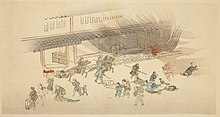Uprising at the Hamaguri Gate
The uprising at the Hamaguri Gate ( Japanese 蛤 御 門 の 変 , Hamaguri-gomon no Hen ) or uprising at the Forbidden Gates ( 禁 門 の 変 , Kinmon no Hen ) took place on August 20, 1864 in Kyōto . It reflected the dissatisfaction of the pro-imperial or xenophobic population groups ( sonnō jōi ).
The uprising and its consequences
In 1863, almost a year earlier, the samurai of the Chōshū domain, who had attempted a coup on September 30, were expelled from Kyoto. Then, after the Ikedaya Incident (池田 屋 事件) of July 8, in which many Chōshū activists were killed by agents of the shogunate, a counterattack proposed by Maki Yasuomi (真 木 保 臣; 1813–1864) and others was proposed by Chōshu officially supported.
Chōshū troops marched to Kyōto and demanded pardon for the nobles loyal to the emperor who had to flee during the September coup. When Maki and Kuzaka Genzui (久 坂 玄 瑞; 1840–1864), another extreme of the Chōshū-han, tried to penetrate the city on August 20, they were repulsed by troops from the domains of Satsuma , Aizu and Kuwana . The fighting led to major fires in the city. Kusaka and Maki committed suicide shortly afterwards. Chōshū was declared an "enemy of the court", the shogunate had to send out a punitive expedition by order of the court, the first of the "Chōshū expeditions".
literature
- S. Noma (Ed.): Hamaguri Gomon Incident . In: Japan. An Illustrated Encyclopedia. Kodansha, 1993, ISBN 4-06-205938-X , p. 494.
- Suzuki Tsutomu: Kaikoku to Jōi. Nihon rekishi shirizu dai-17-kan . (The Opening of the Country and Xenophobia), Tokyo 1966, p. 216
